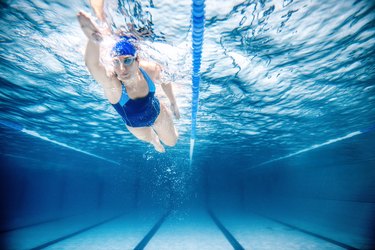
Healing a second-degree burn remains no trivial matter and swimming with healing burns is not recommended. Characterized by broken skin and deeper damage to the epidermis, second-degree burns prove more serious than first degree burns.
Many people get second-degree burns from extended exposure to dangerous UV rays from the sun, causing a deeply uncomfortable and painful sunburn. Limit activities that irritate your skin following a second-degree burn, including exposing your skin to chlorine or ocean water through swimming.
Video of the Day
Video of the Day
Tip
Avoid swimming with healing burns until the skin is healed. The chemicals in the water may irritate the burn. If the burn is blistered or caused broken skin, swimming or bathing may result in an infection.
Degrees of Burns
Three degrees of burns correspond to the layers of skin each type affects. First degree, or surface burns, remain the least harmful type of burn and surface simply through exposure to the sun or touching a hot stove. You'll find recovery quick and more uncomfortable than painful.
Doctors characterize more serious second-degree burns by blistering and broken skin. With a second-degree burn, the first layer of skin bubbles and blisters as well as turning red. With treatment, second-degree burns usually heal with little or no scarring within about three weeks, advises the City of Palm Springs, California.
A third-degree burn, the most serious burn, affects all layers of skin as well as possibly organs, muscles, tendons and ligaments. Third-degree burns can even cause permanent nerve and tissue damage and usually result in dense scarring.
Healing and Treatment
Healing a second-degree burn takes patience and caution. Wash the affected area with warm water immediately after the skin has been burned. Cover the burn with a sterile gauze, remaining particularly careful not to pop any blisters. The burn may itch as it heals but be sure not to scratch it as this may damage the skin and cause infection.
Don't apply topical burn creams or ice to a second-degree burn as this impedes the healing process and, in the case of ice, even causes frostbite. A second-degree burn is usually considered minor if it covers less than 15 percent of your body, states the City of Palm Springs, California. Seek medical attention if the burn is larger than 2 or 3 inches in diameter.
Combining second-degree burns and bathing is not recommended. You should also opt for showers until your skin heals, especially if your burn is more serious. The new skin will be very sensitive, so always test the temperature of the water before getting in.
Swimming With Healing Burns
Exposing broken skin to the chemicals in pool water or the high salt content of ocean water is a recipe for irritation and possible infection. Swimming after a second-degree burn leads to possible complications with the burn, as the chemicals can penetrate the layer of broken skin and cause issues with healing. Avoid swimming until the burn fully heals and no unbroken skin remains anywhere on the body.
Preventing Second-Degree Burns
Since many people contract second-degree burns through extended exposure to the sun, prevent them easily through regular sunblock application and skin care. Always use a full spectrum sunblock of at least SPF 30 strength when spending time in direct sunlight, and reapply regularly throughout the day. For other causes of second-degree burns, always use caution and proper protection when dealing with fire and other hot elements in your environment.